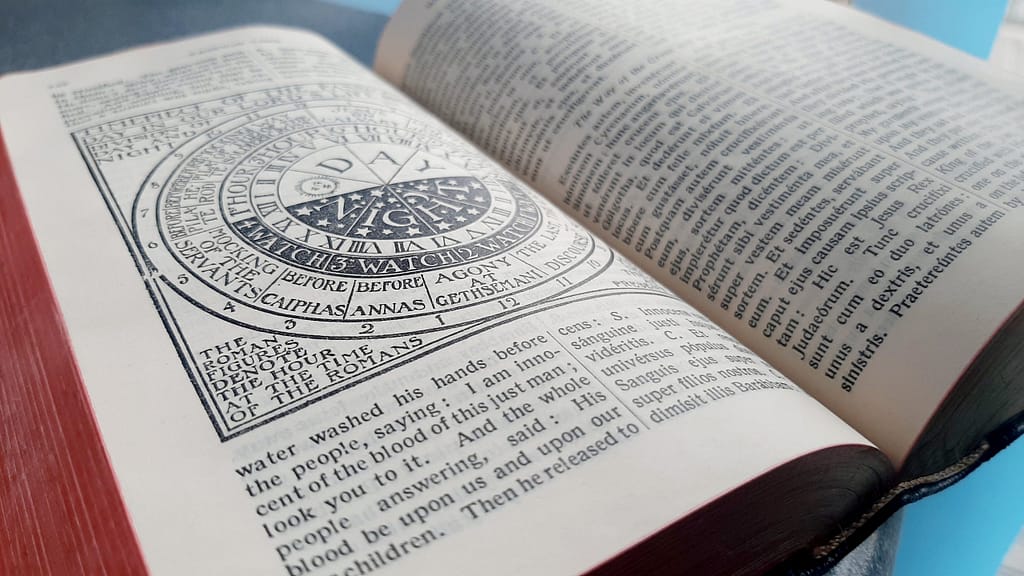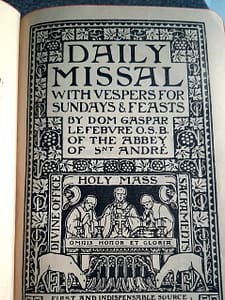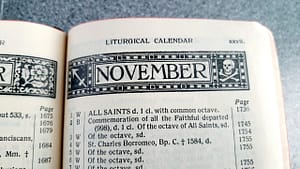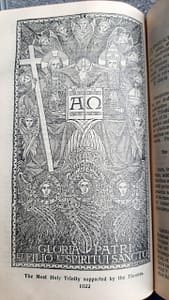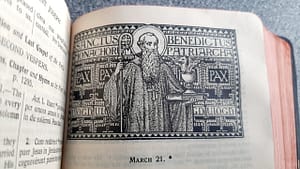A surprisingly challenging project to replace the ribbons in this famous 1920s hand Missal, full of stunning illustrations and learned commentary
Sometimes, a client’s ‘simple request’ can be fraught with hidden complexities. “It only needs the ribbons replacing, really” is what I was told, and yet, performing that task on this book would prove to be more involved than can be anticipated. Fortunately, I find working on hand Missals and other Catholic prayer books fascinating. Not only is the publication itself the fruit of a tremendous amount of work, but the ‘Particulars’ of the book in front of me can be intriguing as well! This one has a little card pasted into the front, from “the Lady Abbess” of St. Mary’s Abbey, East Bergholt, wishing the owner all the best for the future, and dated 1st June 1931 (see the pictures below). Sadly, no name of the owner or the Abbess can be found within the pages. Trying to find the Abbess’ name lead me to discover that a runaway nun wrote about her experiences at this abbey back in 1909! I won’t rob you of the pleasure of reading about that for yourselves.
As for the structure of the book, this one was a little unusual. Most books with a sewn textblock these days have a ‘hollow spine’, so when you open it, the cover moves away from the spine as the pages flex open, which makes a little ‘tunnel’ called a ‘hollow’ between the cover and the pages (try it on a hard back and you’ll see what I mean). This one, however, is a ‘tightback’, so the spine cover is literally glued to the pages. This means when you open the book, the spine covering has to bend as well, which typically leads to a wrinkled spine, and to the leather cracking and flaking off. You can see the brown spots where the dye has worn away. This structure is by no means unheard of, but I’ve not seen one on a little Roman Missal like this before.
The upshot being that I need to ‘dismantle’ the book to get at the spine so I can replace the ribbons. Since the end bands need replacing too, and the plain black end papers are pretty boring, cutting the book out of this casing also allows me to add some nicer design elements to an otherwise plain book. Aside from this, it was in very good condition – no loose pages, and the edge gilding was still remarkably bright – you can see it shining in the picture above.
To add to my workload, the slipcase this came in was, shall we say….derelict. A slipcase for books should help protect them when travelling, but when it’s more tape than case, it’s time for a new one. It’d be a shame to let the book go back out into the world with that sorry-looking case, so I’m pleased the client agreed and is paying for the new case too. We all know these books get thrown in bags onto the passenger seat of the car, especially when trying to get 3 kids in the car at the same time (the situation this owner faces every week!), so this book will need some protection!
For those who don’t recognise the name, the St. Andrew’s Daily Missal is one of the most famous fruits of the Liturgical Movement, and the masterpiece of Dom Gaspar Lefebvre OSB, a Benedictine monk from St. Andrew’s Abbey (hence the name) near Bruges, in Belgium. Sadly, there is very little information about him online (in English, at least), but he lived from 1880 – 1966, travelled extensively to monastic communities in France, Brazil, and eventually Belgium, where he settled, and edited this edition of the Roman Missal. One of the goals of the Liturgical Movement was to help the laity participate more fully (practically and spiritually) in the celebration of the Church’s Liturgy, “This fount of living water which springs up in our hearts” [from the Preface]. As such, the St. Andrew’s Daily Missal is not only comprehensive in its contents (containing also the Offices of Prime, Vespers, and Compline, and numerous devotional prayers) but is quite simply chock-full of Dom Lefebvre’s wonderful commentaries, and stunning artwork created especially for this book by René de Cramer, a professor at the University of Ghent.
Nearly every page of this Missal has something on it that made me pause and look a little closer. I’ve taken pictures of some of my favourites, and they’re in the gallery below. I was particularly taken with this fascinating diagram of the final day of Our Lord’s life before His Crucifixion, inserted into the long Passion Gospel reading for Palm Sunday (the featured image of this post). With all the “at the ninth hour…” information that Gospel passage contains, it can be hard to get a sense of when and where we are in following Jesus through His Passion, since we don’t tell time in that fashion anymore. To help even further, there’s a map of Jerusalem on the preceding page with arrows plotting Jesus’ course through the city on Good Friday.
Finally, in the Preface, Dom Lefebvre mentions that the practice of everyone making the responses at Low Mass “will perhaps surprise many Catholics who are not accustomed to it.” [pg xxxiii]. It surprised me; at most of the Masses I assit at this still hasn’t caught on. I wonder how he’d feel about that, given that “It was a custom which existed in the time of St. Pius V.” [ibid]. Does the congregation make the responses out loud at the Traditional Latin Mass you go to? Should they? I’m genuinely curious about this, so leave a comment below.
The longest part of the process was carefully pealing the old, somewhat dried out leather away from the spine. Once that was done, cleaning all the old linings off the textblock ‘reset’ the book, and I could get to work refreshing the look of the volume. I added four new colourful ribbons, and a red-and-gold striped endband, and replaced those dull, black endpapers with marbled paper. Best of all, I redyed the spine where the leather had worn away, and I think it looks terrific. A simple yet sturdy slipcase completed the project, and the Missal is back in the hands of its happy owner. I can only hope the Lady Abbess would be happy that I’ve kept her thoughtful gift in working order for some time to come! Take a look at the before-and-after shots below and let me know what you think by leaving a comment at the bottom of the page.
Is there a worn out old hand missal gathering dust on a shelf in your house? Whether the leather is cracked or the ribbons have snapped, I’m sure there’s something I can do to help. If your house happens to be a presbytery and the missals are a bit bigger than this one, I can still help – check out the work I did on this 1962 altar Missal for a hermit!


